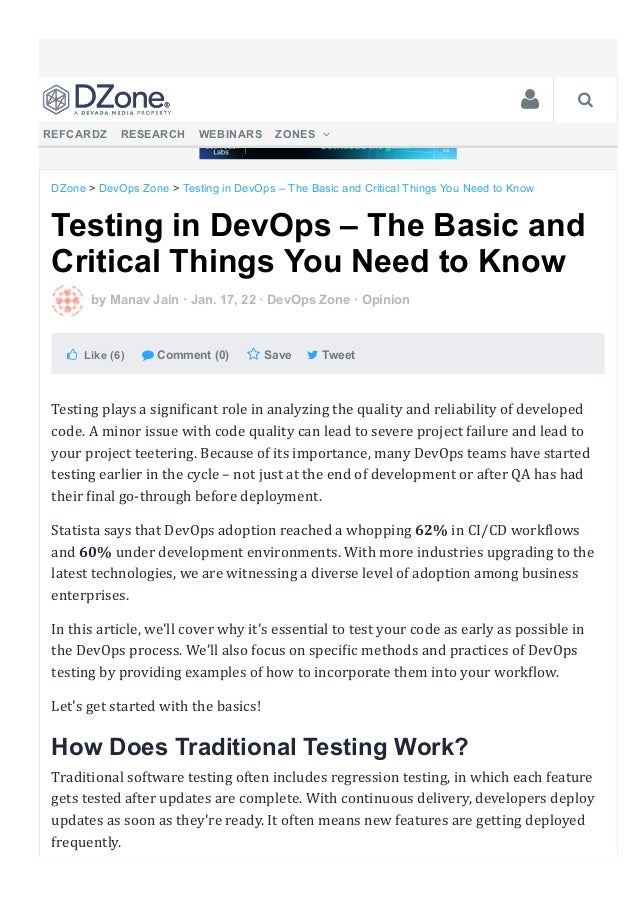Testing in DevOps ŌĆō The Basic and Critical Things You Need to Know
- 1. Testing┬Āin┬ĀDevOps┬ĀŌĆō┬ĀThe┬ĀBasic┬Āand Critical┬ĀThings┬ĀYou┬ĀNeed┬Āto┬ĀKnow ┬Āby┬ĀManav┬ĀJain┬ĀĻ×Å┬ĀJan.┬Ā17,┬Ā22┬ĀĻ×Å┬ĀDevOps┬ĀZone┬ĀĻ×Å┬ĀOpinion ŅĪć ┬ĀLike┬Ā(6) ┬Ā ŅĪĀ┬ĀComment┬Ā(0) ┬Ā ŅĀÆ┬ĀSave ┬Ā┬Ā Ņ¦¢┬ĀTweet┬Ā Testing┬Āplays┬Āa┬Āsigniļ¬Ł’ĆŹicant┬Ārole┬Āin┬Āanalyzing┬Āthe┬Āquality┬Āand┬Āreliability┬Āof┬Ādeveloped code.┬ĀA┬Āminor┬Āissue┬Āwith┬Ācode┬Āquality┬Ācan┬Ālead┬Āto┬Āsevere┬Āproject┬Āfailure┬Āand┬Ālead┬Āto your┬Āproject┬Āteetering.┬ĀBecause┬Āof┬Āits┬Āimportance,┬Āmany┬ĀDevOps┬Āteams┬Āhave┬Āstarted testing┬Āearlier┬Āin┬Āthe┬Ācycle┬ĀŌĆō┬Ānot┬Ājust┬Āat┬Āthe┬Āend┬Āof┬Ādevelopment┬Āor┬Āafter┬ĀQA┬Āhas┬Āhad their┬Āļ¬Ł’ĆŹinal┬ĀgoŌĆæthrough┬Ābefore┬Ādeployment. Statista┬Āsays┬Āthat┬ĀDevOps┬Āadoption┬Āreached┬Āa┬Āwhopping┬Ā62%┬Āin┬ĀCI/CD┬Āworkļ¬Ł’ĆŹlows and┬Ā60%┬Āunder┬Ādevelopment┬Āenvironments.┬ĀWith┬Āmore┬Āindustries┬Āupgrading┬Āto┬Āthe latest┬Ātechnologies,┬Āwe┬Āare┬Āwitnessing┬Āa┬Ādiverse┬Ālevel┬Āof┬Āadoption┬Āamong┬Ābusiness enterprises. In┬Āthis┬Āarticle,┬Āwe'll┬Ācover┬Āwhy┬Āit's┬Āessential┬Āto┬Ātest┬Āyour┬Ācode┬Āas┬Āearly┬Āas┬Āpossible┬Āin the┬ĀDevOps┬Āprocess.┬ĀWeŌĆÖll┬Āalso┬Āfocus┬Āon┬Āspeciļ¬Ł’ĆŹic┬Āmethods┬Āand┬Āpractices┬Āof┬ĀDevOps testing┬Āby┬Āproviding┬Āexamples┬Āof┬Āhow┬Āto┬Āincorporate┬Āthem┬Āinto┬Āyour┬Āworkļ¬Ł’ĆŹlow. Let's┬Āget┬Āstarted┬Āwith┬Āthe┬Ābasics! How┬ĀDoes┬ĀTraditional┬ĀTesting┬ĀWork? Traditional┬Āsoftware┬Ātesting┬Āoften┬Āincludes┬Āregression┬Ātesting,┬Āin┬Āwhich┬Āeach┬Āfeature gets┬Ātested┬Āafter┬Āupdates┬Āare┬Ācomplete.┬ĀWith┬Ācontinuous┬Ādelivery,┬Ādevelopers┬Ādeploy updates┬Āas┬Āsoon┬Āas┬Āthey're┬Āready.┬ĀIt┬Āoften┬Āmeans┬Ānew┬Āfeatures┬Āare┬Āgetting┬Ādeployed frequently. DZone┬Ā>┬ĀDevOps┬ĀZone┬Ā>┬ĀTesting┬Āin┬ĀDevOps┬ĀŌĆō┬ĀThe┬ĀBasic┬Āand┬ĀCritical┬ĀThings┬ĀYou┬ĀNeed┬Āto┬ĀKnow ŅĀĢ ┬Ā ŅĀŗ REFCARDZ ┬ĀRESEARCH ┬ĀWEBINARS ┬ĀZONES┬Ā ŅŻÜ







